At a swap meet, I bought a 2-ton beam trolley with a broken roller (you can see the flange broken off the top-right roller):
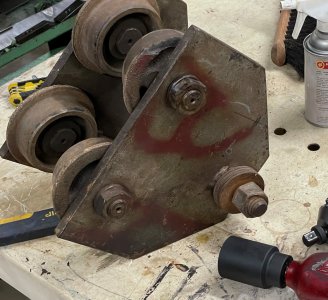
I TIG brazed some Al-Bronze to fill the missing section:
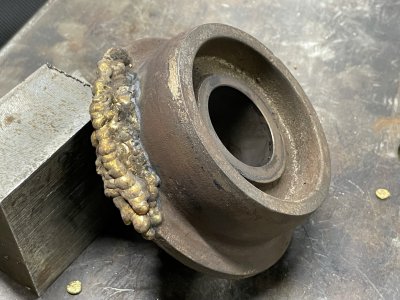
Then I wanted to machine it to match the old roller. I turned down some pipe in the 3-jaw to serve as a mandrel with a shoulder and used a disc with a center hole in it to press with the roller onto the mandrel:
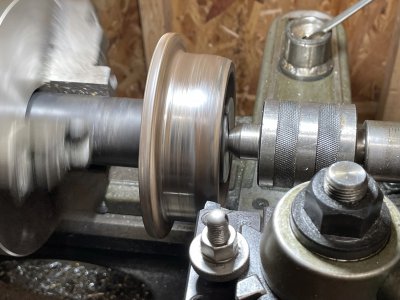
Machining the bronze wasn't bad, but the roller body itself had about 1/8" runout! I was shocked it was that bad, but since I was holding it by the bearing surface, it seemed inescapable that the trolley would roll like crap. So I decided to true the roller as I machined the bronze:
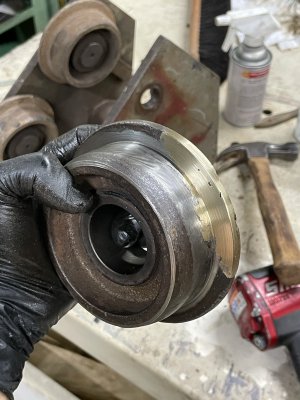
It's no beauty, but it was one of my first times TIG brazing, and seems reasonable. You can see there was some issue machining the roller itself, which seems to be very hard steel. Since all four rollers had the same concentricity problem, I ignored the issues with the first and pressed on.
I experimented with a variety of tools: HSS died very quickly, some inserted carbide chipped quickly, some did okay, and the brazed carbide seemed to wear and chip, but less than some of the inserts. I was enjoying sharpening carbide on my Rockwell grinder (23-501), so I stuck with the brazed carbide. Here's about what it looked like after sharpened:
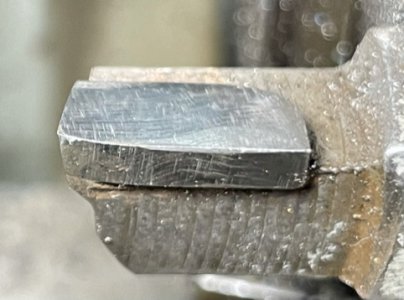
You can see where I needed to make the tip angle a little more obtuse to remove the damaged material from prior passes; this is what it looked like after two passes:
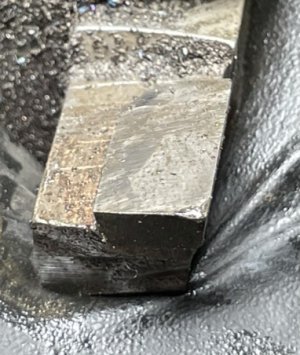
After repeating that cycle and seeing my lathe really show some unseemly deflection in the cut, I realized I should think about speed. Foolishly, I had turned my lathe down to its slowest speed without going to the back gears, so I was at about 350-400 rpm, which for the 4" diameter, was about 400 sfm. As I tried slower speeds, I realized I was just pushing too fast for the material, and saw major improvement when I got down to about 100 sfm. Here's a video showing the three speeds I tried:
So, I learned something, and think that the trolley should roll much better now than before:
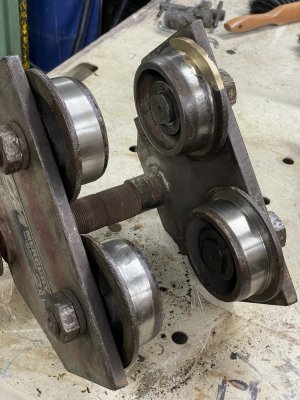
The top left roller is the last one, where I figured out that slowing down was a major improvement. In the lower left roller, you can see the ripples from pushing on with a damaged tool. I may go back and clean them all up now that I have the parameters figured out, but I think I'll probably leave it be.
Note on my carbide tool: I have a container of brazed carbide, and grabbed one that turns out to be an Iscar IC2 grade. I also seem to have Iscar IC70. This chart seems to correlate those with C2 and C7. This chart seems to show my IC2 as for cast iron but more general applicability, whereas the IC70 is less tough and more for finishing ferrous material. Neither seems all that appropriate for the job and that may explain some of my issues. The somewhat generic inserts I have may have done better once I turned the speed down.
I appreciate any further advice you may have.

I TIG brazed some Al-Bronze to fill the missing section:

Then I wanted to machine it to match the old roller. I turned down some pipe in the 3-jaw to serve as a mandrel with a shoulder and used a disc with a center hole in it to press with the roller onto the mandrel:

Machining the bronze wasn't bad, but the roller body itself had about 1/8" runout! I was shocked it was that bad, but since I was holding it by the bearing surface, it seemed inescapable that the trolley would roll like crap. So I decided to true the roller as I machined the bronze:

It's no beauty, but it was one of my first times TIG brazing, and seems reasonable. You can see there was some issue machining the roller itself, which seems to be very hard steel. Since all four rollers had the same concentricity problem, I ignored the issues with the first and pressed on.
I experimented with a variety of tools: HSS died very quickly, some inserted carbide chipped quickly, some did okay, and the brazed carbide seemed to wear and chip, but less than some of the inserts. I was enjoying sharpening carbide on my Rockwell grinder (23-501), so I stuck with the brazed carbide. Here's about what it looked like after sharpened:

You can see where I needed to make the tip angle a little more obtuse to remove the damaged material from prior passes; this is what it looked like after two passes:

After repeating that cycle and seeing my lathe really show some unseemly deflection in the cut, I realized I should think about speed. Foolishly, I had turned my lathe down to its slowest speed without going to the back gears, so I was at about 350-400 rpm, which for the 4" diameter, was about 400 sfm. As I tried slower speeds, I realized I was just pushing too fast for the material, and saw major improvement when I got down to about 100 sfm. Here's a video showing the three speeds I tried:
So, I learned something, and think that the trolley should roll much better now than before:

The top left roller is the last one, where I figured out that slowing down was a major improvement. In the lower left roller, you can see the ripples from pushing on with a damaged tool. I may go back and clean them all up now that I have the parameters figured out, but I think I'll probably leave it be.
Note on my carbide tool: I have a container of brazed carbide, and grabbed one that turns out to be an Iscar IC2 grade. I also seem to have Iscar IC70. This chart seems to correlate those with C2 and C7. This chart seems to show my IC2 as for cast iron but more general applicability, whereas the IC70 is less tough and more for finishing ferrous material. Neither seems all that appropriate for the job and that may explain some of my issues. The somewhat generic inserts I have may have done better once I turned the speed down.
I appreciate any further advice you may have.

